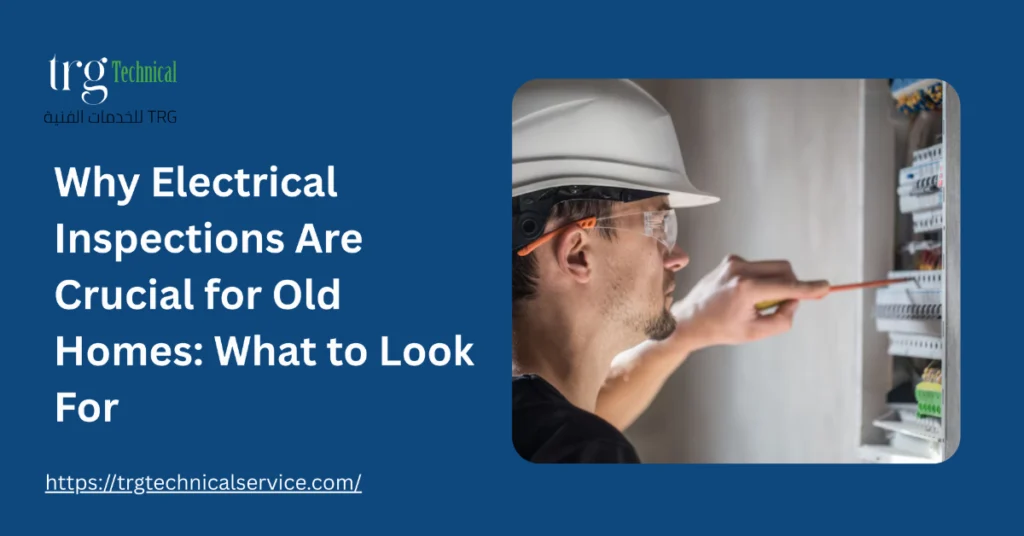Why Electrical Inspections Are Crucial for Old Homes: What to Look For

Owning an older home can be rewarding—it often comes with charm, character, and unique architecture that newer properties may lack. However, while vintage aesthetics are appealing, the underlying electrical systems in older homes can be a hidden hazard. Many of these homes were built before modern electrical codes and may not be equipped to handle today’s technology-driven lifestyles.
That’s why electrical inspections are critical for old homes. If you live in or are considering purchasing an older property, knowing what to look for during an electrical inspection could prevent costly repairs—or even life-threatening dangers.
The Risks of Outdated Electrical Systems
Older homes—typically those built before the 1980s—often have electrical systems that are outdated or degraded. Here are some common issues:
1. Outdated Wiring (Knob and Tube or Aluminum)
Knob-and-tube wiring was commonly used in homes built before the 1950s. While it may still function, it lacks grounding and cannot handle the electrical demands of modern appliances. Aluminum wiring, popular in the 1960s and 70s, poses fire risks due to its tendency to oxidize and loosen at connections.
2. Insufficient Electrical Capacity
Most older homes were built when the average electrical demand per household was much lower. A 60-amp service panel may have been sufficient in the 1950s, but today’s homes often require at least 150 to 200 amps to support air conditioners, microwaves, home offices, and other high-load devices.
3. Worn or Damaged Components
Over time, electrical components such as outlets, switches, breakers, and wiring degrade. Worn insulation, rusted panels, and loose connections can lead to electrical arcing, shorts, or even fire.
4. Lack of Ground Fault and Arc Fault Protection
Many older homes were built before GFCI (Ground Fault Circuit Interrupter) and AFCI (Arc Fault Circuit Interrupter) protection became code requirements. These devices are now required in kitchens, bathrooms, bedrooms, and outdoor circuits to reduce the risk of electric shock and fire.
Read also: Electrical Services for Renovations: How to Safely Update Your Wiring
Why an Electrical Inspection Is Non-Negotiable
A thorough inspection ensures your home meets modern safety standards and can identify problems early. Here’s why inspections are especially important in older properties:
Safety First
The primary reason to conduct an electrical inspection is safety. Faulty wiring is one of the leading causes of residential fires. An inspection can reveal:
-
Overloaded circuits
-
Faulty breakers or fuses
-
Improper grounding
-
Potential shock hazards
Insurance Requirements
Many insurance providers require an electrical inspection before approving coverage for older homes. Some may even deny coverage altogether if knob-and-tube or aluminum wiring is present.
Pre-Renovation or Real Estate Purchase
If you plan to renovate or purchase an old home, a preemptive inspection can help you budget for necessary electrical upgrades. It can also be a bargaining tool in real estate negotiations.
Protecting Your Investment
Your home is one of your most significant investments. Regular electrical inspections help maintain its value and ensure all systems are functioning properly.
Read also: How Safety Standards Affect Erection Service Providers
What to Look For During an Electrical Inspection
When hiring a licensed electrician for an inspection, these are the critical elements they will (and should) evaluate:
1. Main Electrical Panel
The electrician will check the panel’s capacity, the condition of breakers, proper labeling, grounding, and signs of corrosion or overheating.
2. Wiring Type and Condition
Inspectors will identify the type of wiring in use (copper, aluminum, or knob-and-tube) and check for damage, fraying, or improper installations.
3. Outlets and Switches
A thorough check of receptacles and switches includes:
-
Proper grounding
-
GFCI functionality in wet areas
-
Signs of discoloration or overheating
-
Loose or unresponsive outlets
4. Circuit Load Testing
Electricians may perform load testing to see if your circuits can handle modern demand without tripping breakers or overheating.
5. Code Compliance
The inspection will verify that your electrical system meets current NEC (National Electrical Code) standards, which have evolved significantly over the years.
6. Exterior Electrical Components
Outdoor lighting, garage wiring, and exterior outlets must also meet safety standards, particularly for weatherproofing and GFCI protection.
Read also: The Crucial Role of Erection Services in Construction Projects
What Happens After the Inspection?
After the inspection, you’ll receive a report outlining:
-
Any code violations
-
Safety concerns
-
Recommended upgrades or repairs
-
Cost estimates (if the inspector is also a contractor)
Depending on the findings, you may need to:
-
Replace the electrical panel
-
Upgrade wiring
-
Add GFCI or AFCI protection
-
Increase overall system capacity
Electrical Upgrades to Consider for Older Homes
If your inspection reveals issues, here are common upgrades that improve safety and functionality:
-
Rewiring to replace outdated knob-and-tube or aluminum
-
Installing a modern 200-amp panel
-
Adding surge protection for sensitive electronics
-
Replacing ungrounded two-prong outlets with grounded three-prong ones
-
Installing smart home-compatible wiring or energy-efficient systems
While the cost of upgrades can be significant, the benefits—reduced fire risk, higher property value, and peace of mind—make it a smart long-term investment.
Conclusion
Old homes have stories, charm, and personality—but their electrical systems often come with hidden risks. Regular electrical inspections are not just good practice—they’re essential for safety, compliance, and long-term property health. Whether you’ve just moved in, plan to renovate, or are simply unsure of your home’s electrical integrity, now is the time to schedule a comprehensive inspection.
For professional electrical inspection and upgrade services in the UAE, trust
TRG Technical Services—experienced, licensed electricians who understand the complexities of older homes and deliver code-compliant solutions with your safety in mind.


